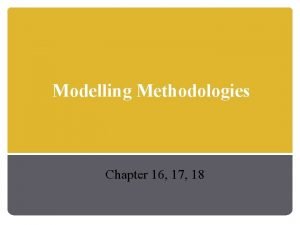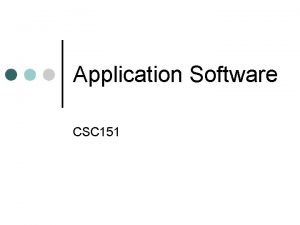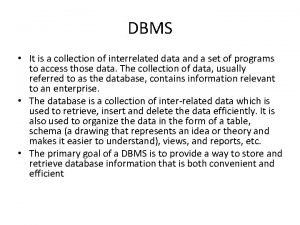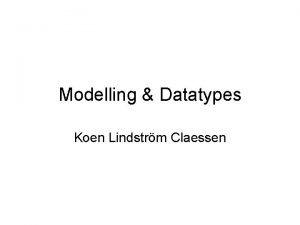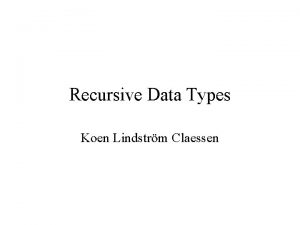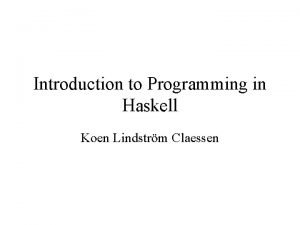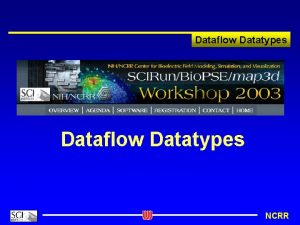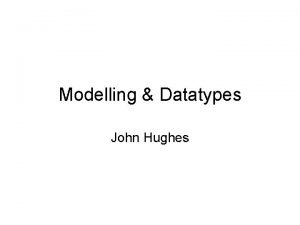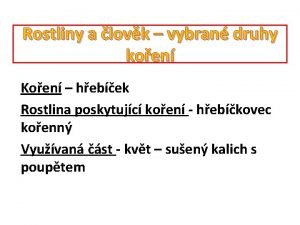Modelling Datatypes Koen Lindstrm Claessen Software Programs Data

































- Slides: 33

Modelling & Datatypes Koen Lindström Claessen

Software = Programs + Data

Modelling Data • A big part of designing software is modelling the data in an appropriate way • Numbers are not good for this! • We model the data by defining new types

Modelling a Card Game • Every card has a suit Hearts, Whist, Plump, Bridge, . . . • Model by a new type: data Suit = Spades | Hearts | Diamonds | Clubs The new type The values of this type

Investigating the new type Main> : i Suit -- type constructor data Suit -- constructors: Spades : : Suit Hearts : : Suit Diamonds : : Suit Clubs : : Suit Main> : i Spades : : Suit -- data constructor The new type The new values -- constructors Types and constructors start with a capital letter

Printing Values Main> Spades ERROR - Cannot find "show" function for: *** Expression : Spades Needed to print *** Of type : Suit values Main> : i show : : Show a => a -> String -- class member • Fix data Suit = Spades | Hearts | Diamonds | Clubs deriving Show Main> Spades

The Colours of Cards • Each suit has a colour – red or black • Model colours by a type data Colour = Black | Red deriving Show • Define functions by pattern matching colour : : Suit -> Colour colour Spades = Black colour Hearts = Red colour Diamonds = Red colour Clubs = Black One equation per value Main> colour Hearts Red

The Ranks of Cards • Cards have ranks: 2. . 10, J, Q, K, A • Model by a new type Numeric ranks data Rank = Numeric Integer | Jack | Queen | King | Ace deriving Show Numeric ranks contain an Integer Main> : i Numeric : : Integer -> Rank -- data constructor Main> Numeric 3

Rank Beats Rank • When does one rank beat another? A K Q J m m>n n J Q K A

Rank Beats Rank rank. Beats : : Rank -> Bool

Rank Beats Rank • When does one rank beat another? A K Q J m m>n n J Q K A

Rank Beats Rank • When does one rank beat another? A K Q J m m>n n J Q K A

Rank Beats Rank rank. Beats : : Rank -> Bool rank. Beats _ Ace = False Matches anything at all Nothing beats an Ace

Rank Beats Rank • When does one rank beat another? A K Q J m m>n n J Q K A

Rank Beats Rank rank. Beats : : Rank -> Bool rank. Beats _ Ace = False An Ace beats anything else rank. Beats Ace _ = True Used only if the first equation does not match.

Rank Beats Rank • When does one rank beat another? A K Q J m m>n n J Q K A

Rank Beats Rank rank. Beats : : Rank -> Bool rank. Beats _ Ace = False rank. Beats Ace _ = True rank. Beats _ King = False rank. Beats King _ = True

Rank Beats Rank • When does one rank beat another? A K Q J m m>n n J Q K A

Rank Beats Rank rank. Beats : : Rank -> Bool rank. Beats _ Ace = False rank. Beats Ace _ = True rank. Beats _ King = False rank. Beats King _ = True rank. Beats _ Queen = False rank. Beats Queen _ = True rank. Beats _ Jack = False rank. Beats Jack _ = True

Rank Beats Rank • When does one rank beat another? A K Q J m m>n n J Q K A

Rank Beats Rank rank. Beats : : Rank -> Bool rank. Beats _ Ace = False rank. Beats Ace _ = True rank. Beats _ King = False rank. Beats King _ = True rank. Beats _ Queen = False rank. Beats Queen _ = True rank. Beats _ Jack = False rank. Beats Jack _ = True rank. Beats (Numeric m) (Numeric n) = m > n Match Numeric 7, for example Names the number in the rank

Examples Main> rank. Beats Jack (Numeric 7) True Main> rank. Beats (Numeric 10) Queen False

Modelling a Card • A Card has both a Rank and a Suit data Card = Card Rank Suit deriving Show • Define functions to inspect both rank : : Card -> Rank rank (Card r s) = r suit : : Card -> Suit suit (Card r s) = s

A Useful Abbreviation • Define type and inspection functions together, as follows data Card = Card {rank : : Rank, suit : : Suit} deriving Show

When does one card beat another? • When both cards have the same suit, and can be written the rank is higher down simpler. . . card. Beats : : Card -> Bool card. Beats c c' | suit c == suit c' = rank. Beats (rank c) (rank c') | otherwise = False data Suit = Spades | Hearts | Diamonds | Clubs deriving (Show, Eq)

When does one card beat another? • When both cards have the same suit, and the rank is higher card. Beats : : Card -> Bool card. Beats c c' = suit c == suit c’ && rank. Beats (rank c) (rank c')

Intermezzo: Figures • Modelling geometrical figures – triangle – rectangle – circle data Figure = Triangle. . . | Rectangle. . . | Circle. . . circumference : : Figure -> Double circumference =. . .

Intermezzo: Figures data Figure = Triangle Double | Rectangle Double | Circle Double circumference : : Figure -> Double circumference (Triangle a b c) = a + b + c circumference (Rectangle x y) = 2* (x + y) circumference (Circle r) = 2 * pi * r

Intermezzo: Figures data Figure = Triangle Double | Rectangle Double | Circle Double -- types Triangle : : Double -> Figure Rectangle : : Double -> Figure Circle : : Double -> Figure square s = Rectangle s s

Modelling a Hand of Cards • A hand may contain any number of cards from zero up! data Hand = Cards Card … Card deriving Show • The solution is… recursion! We can’t use …!!!

Modelling a Hand of Cards • A hand may contain any number of cards from zero up! – A hand may be empty very much like a – It may consist of a first card and the restlist. . . • The rest is another hand of cards! data Hand = Empty | Add Card Hand deriving Show A recursive type! Solve the problem of modelling a hand with one fewer cards!

When can a hand beat a card? • An empty hand beats nothing • A non-empty hand can beat a card if the first card can, or the rest of the hand can! hand. Beats : : Hand -> Card -> Bool hand. Beats Empty card = False hand. Beats (Add c h) card = card. Beats c card || hand. Beats h card • A recursive function!

What Did We Learn? • Modelling the problem using datatypes with components • Using recursive datatypes to model things of varying size • Using recursive functions to manipulate recursive datatypes • Writing properties of more complex algorithms
 Petra claessen
Petra claessen Rob claessen
Rob claessen Overview of software engineering
Overview of software engineering Modelling software
Modelling software Consequence modelling software
Consequence modelling software Unit 5 data modelling assignment 2
Unit 5 data modelling assignment 2 Data modelling techniques in business intelligence
Data modelling techniques in business intelligence Trendlines and regression analysis
Trendlines and regression analysis Define the relationship chapter 16
Define the relationship chapter 16 Power platform data modelling
Power platform data modelling Data modeling concepts
Data modeling concepts Diffractie
Diffractie Internationale competenties
Internationale competenties Koen hoondert
Koen hoondert Dokter thomeer
Dokter thomeer Koen de boeck
Koen de boeck Koen peeters lumc
Koen peeters lumc Koen dewulf west-vlaanderen
Koen dewulf west-vlaanderen Koen titeca
Koen titeca Pengertian kelembagaan sosial
Pengertian kelembagaan sosial Koen vancraeynest
Koen vancraeynest Koen van besien
Koen van besien Koen van deun
Koen van deun Marielle hoeijmans
Marielle hoeijmans Catering sales software
Catering sales software Unlike application software programs
Unlike application software programs What kind of software consists of programs designed
What kind of software consists of programs designed What are the main software categories
What are the main software categories Vendmaster
Vendmaster Use of software
Use of software Inter related data
Inter related data Programs that organize analyze and graph numerical data
Programs that organize analyze and graph numerical data Open data programs
Open data programs Algorithms + data structures = programs
Algorithms + data structures = programs








